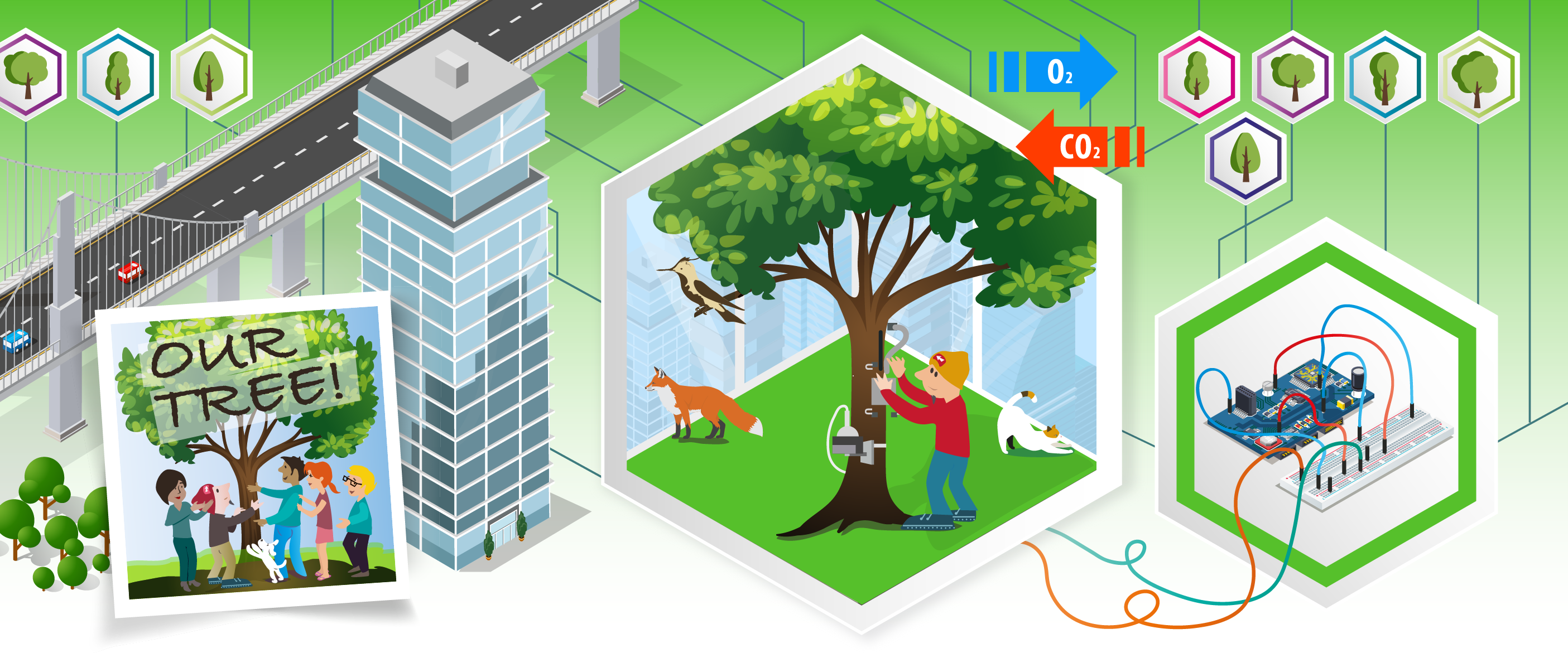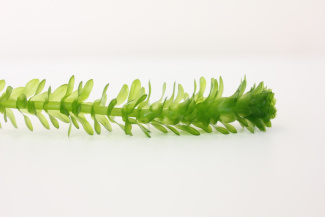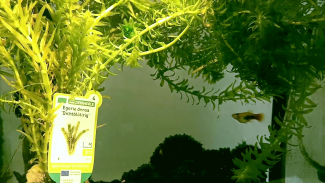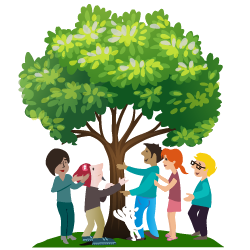Adopt a Tree - Green Almighty

Overview
Overview
Keywords: Plant biology
Disciplines: Physics, biology
Age level of the students: 10-15
Time frame: 45 - 90 minutes per activity (plus time for the measurement to run)
![]()
![]()
![]()
Water plant photosynthesis
As plants produce oxygen, which is invisible and odorless, this experiment is carried out with water plants, so the bubbles of the produced oxygen are easily observed.


Plants are an important part of the carbon cycle, and their reproduction is key to the world's nutrition. With photosynthesis they transform carbon dioxide, water and sunlight into oxygen and simple sugars which they use as fuel. As primary producers they are the base of an ecosystem and fuel the next trophic levels. Photosynthesis is important to oxygen-requiring organisms because it is the primary source of oxygen in the atmosphere. Without photosynthesis, the carbon cycle could not take place, and oxygen-requiring life would not survive.
To demonstrate photosynthesis, it is advantageous to use submerged aquatic plants over terrestrial plants because:
- terrestrial plants face a lot of challenges when underwater which restricts oxygen production
- the forming oxygen bubbles by aquatic plants can be collected via H2O
Submerged plants in constructed wetlands have the potential for secondary treatment of wastewater, and the main area of their application is the last step in multistage systems. Their activity leads to the reduction of the amount of soluble carbon dioxide in water as in the period of high photosynthetic activity they increase the amount of dissolved oxygen. The use of submerged plants in constructed wetlands is limited right now to the experimental scale.
Egeria densa is a highly desired water plant in aquaria and small ponds for its oxygenating capabilities but has become a serious invasive species in larger bodies of fresh water, where dense mats reduce recreational options and crowd out native species as well as obstruct fish migration patterns and habitats, restrict water and boat movement, etc. Consequently, all water plants used in the classroom or school laboratory should be properly disposed of as domestic garbage and in no case be introduced into local freshwater sources.
What the students do
Students are asked to watch the “Water plant photosynthesis” video, replicate the process and record their findings.
Materials
- Egeria densa (Brazilian waterweed)
- Glass or clear plastic jar with lid
- Tap water
- Tap water infused with carbon dioxide by exhaling into it using a drinking straw
- If available, water from an aquarium or a pond which is probably rich in carbon dioxide due to decomposition of organic matter
- Carbonated water slowly poured into the jar and left to rest
- The clear upper part of a baking soda solution (1 teaspoon per 1 glass of water) which must be left to rest for a few hours as the initially cloudy water will inhibit photosynthesis
For this experiment you can use either direct sunlight or strong artificial light from a table lamp. Students should also be able to distinguish between the oxygen bubbles which form on the leaves or come out of the cut stems of the plants, and the tiny carbon dioxide bubbles that might rise in the very beginning of the experiment. As photosynthesis occurs, Egeria densa plants pass the produced oxygen from leaves to stem. Some oxygen escapes from the leaves to form oxygen bubbles in the water but the majority escapes from the stem because of larger intracellular air spaces.
Capillary action
When three forces called cohesion, adhesion, and surface tension work together then a liquid moves up something solid, like a tube or into a material with a lot of small holes.
All plants need water to survive. Plants use water to carry nutrients to their roots, stems, leaves and flowers and to prevent drying out and wilting. Just as humans have veins and arteries that move blood around inside the body, plants have xylem, which consists of millions of tiny tubes made of cellulose, to move water.
Water molecules travel up the narrow tubes allowing the plant to get nutrients from the soil. This capillary action helps bring water up into the roots, but it can only pull water up a small distance, after which it cannot overcome gravity. Because water molecules like to stick together (cohesion) and like to stick to the walls of the tubes of cellulose (adhesion), they rise in the tubes all the way from the roots to the leaves. Water then evaporates from the leaves, helping to draw up more water from the roots. To get water up to all the branches and leaves, the forces of adhesion and cohesion work in the plant's xylem to move water to the furthest leaf.
Watering a rooted plant with coloured water will usually result in little colour change to the plant because the roots keep the generally non-nutrient dye from entering the stele, and subsequently the plant. Any noticeable colour change will likely occur only in plants with white colouring or flowers. Plants lose moisture through the tiny pores in their leaves and when the roots and stems draw up the coloured water, it eventually reaches and colours the flowers.

Work for students
Students watch the “Capillary action” video and replicate the process using Chinese cabbage, celery and white carnations with different colours of food dyes. As the process is influenced by different factors, like evaporation from the leaves, dye concentration and the water temperature, they can repeat the experiment and compare the results with changing parameters:
- One specimen in bright light and one in total darkness,
dye concentration 10 drops per 100 mL of water,
same environment temperature - One specimen in cold water (15 °C) and one in warm (35 °C), dye concentration 10 drops per 100 mL of water, same environment temperature, same light conditions for both
- One specimen in a solution of 5 dye drops / 100 mL and one in a solution of 20 dye drops / 100 mL,
same environment temperature,
same light conditions for both - One specimen near a heat source or a dehumidifier and one in normal conditions,
same light conditions for both,
dye concentration 10 drops per 100 mL of water.
The experiments should last between 3-12 hours each and different dye colours could be tested. Homemade filtered juices from beetroot, carrot or spinach can also be investigated. Students use a camera for before and after pictures, take notes and discuss the results in the classroom.
Stomata and vascular tissue
As plants transport water from the roots to the leaves to replace losses from transpiration, plant plumbing is demonstrated here.
The vascular tissue of plants, which is composed of specialised conducting tissues, xylem and phloem, form continuous systems through the plant body and provide transport pathways for water, nutrients, and signalling molecules, and support a plant body against mechanical stresses. Xylem moves water from the roots to the leaves, and phloem moves nutrients from the leaves to the rest of the plant. Xylem is a tissue consisting of dead cells that form a system of pipes while phloem consists of living cells that form elongated and thin-walled sieve tubes.
Stomata are tiny openings or pores in plant tissue, typically found in plant leaves, that allow for gas and water exchange. Plants that reside on land typically have thousands of stomata on the surfaces of their leaves. The majority of the stomata are located on the underside of plant leaves, reducing their exposure to heat and air currents. In aquatic plants with floating or emergent leaves, stomata are located on their upper leaf surfaces, and usually their stomata are permanently open. Stomata are connected to and work together with the vascular tissue of the plant.

Work for students
Students watch the “Stomata and vascular tissue” video and replicate the experimental setup. Then they repeat the experiment that shows the connection of stomata with other parts of the plant through tiny tubes. To determine the side of the leaf on which stomata are located:
- They meticulously spread petroleum jelly on the upper surface of the leaf and try to suck air through the drinking straw.
- They do the same to the lower surface of the leaf and again try to suck air through the drinking straw.
Students compare the results and report their conclusions.
Materials
- Jar with lid
- Drill to make holes in the lid
- Water
- Modelling clay
- Plant with large leaves like calla lily
- Petroleum jelly
- Paper straw, preferably angled
Transpiration in a jar
Plants put down roots into the soil to draw water and nutrients up into the stems and leaves while a lot of this water is returned to the air by transpiration, also cooling the plant when the weather is very hot.
Transpiration is the process of water movement through a plant and its evaporation from aerial parts, such as leaves, stems and flowers. Water moves from the soil into the plant roots and up through the sapwood into the leaves. The water, warmed by the sun, evaporates and passes out through thousands of stomata found mostly on the underside of the leaf surface. Water is necessary for plants but only a small amount of water taken up by the roots is used for growth and metabolism. Transpiration is crucial to a plant’s survival as it
- Enhances nutrient uptake (ion movement)
- Provides water to keep cells turgid to support the plant
- Supplies water to leaf cells for photosynthesis
- Keeps the leaves cool by evaporation
Transpiration is also an important factor in the water cycle as it is one of the major sources of water in the atmosphere.

Work for students
Students watch the “Transpiration in a jar” video and replicate the process. Instead of the jars, they can use transparent plastic bags as long as they are tightly wrapped around the plant and its pot. They can either use a cut plant stem as in the video or a potted plant. Students are asked to repeat the experiment and compare the results, regarding the observed vapour condensation on the interior surface of the glass or plastic when the set-up is placed:
- in full sunlight
- in total darkness
Materials
- 2 jars with lid (one smaller than the other so it can easily fit into the larger one) or alternatively transparent plastic bags
- Drill to make a hole in the lid of the smaller jar
- Modelling clay
- A plant that likes to stay moist
Please find three interactive exercises for your students below:
A simple potometer
A device used for measuring the rate of water uptake of a leafy shoot which is almost equal to the water lost through transpiration.
A potometer, sometimes known as transpirometer, is a device used for measuring the rate of water uptake of a leafy shoot which is almost equal to the water lost through transpiration. The rate of transpiration can be estimated in two ways:
- Indirectly – by measuring the distance the water level drops in the graduated tube over a measured length of time. It is assumed that this is due to the cutting taking in water which in turn is necessary to replace an equal volume of water lost by transpiration.
- Directly – by measuring the reduction in mass of the potometer over a period of time. Here it is assumed that any loss in mass is due to transpiration.
A simple potometer is a piece of capillary tubing to which a plant has been connected. The water uptake is measured by recording the time taken for a bubble in the tube to move a set distance.
Studying transpiration rates is quite important as the survival of plants stressed by heat and drought depends on the transpiration rate. Too much water loss can leave plants dehydrated. Since water is a limiting factor in many cases, much of crop research is focused on trying to improve plant water use to increase productivity in combination with photosynthesis.

Work for students
Students watch the "A simple potometer" video in order to construct their own instrument by using a repurposed glass jar, some silicone sealant and a glass drinking straw. Then they record the transpiration rates in different conditions (1 measurement per hour):
- full sunlight
- total darkness
- high temperature (plant is placed near a heat source)
- high humidity (plant is covered with a transparent plastic bag)
- wind (plant is placed in front of a table fan)
A glass straw, with an inner diameter of 5 mm, was used for the set-up shown in the following pictures (continuous artificial light: 12 W LED lamp at 20 cm from the closest leaf, temperature: 12.7 °C, humidity: 54.8 % RH). The water uptake of the plant in a time period of 31 hours was calculated as 2.5 grams.
Materials
- Jar with lid
- Drill to make a hole in the lid
- Modelling clay
- Glass straw
- Aquarium-safe silicon
- Pipette
- Vegetable oil
- Printed ruler (download template)
- Plant

Possible community involvement
"Plant blindness" is the inability to recognise or notice the plants in your own environment. For many people, it's far easier to discern or recall an image of an animal than that of a plant, and this deficit diminishes interest in the critical role that plants play in the biosphere and human affairs. Humans and plants have a complex relationship extending far back into our joint evolutionary history. This legacy can be seen today as plants provide nutrition, fibre, pharmaceuticals, and energy for people and animals across the globe. During the height of the pandemic, people flocked to parks. Parks allowed us to lounge on the grass and in the shade of trees, admire flowers, enjoy a walk in the fresh air, or even grow food in a community garden. These moments offered a health boost and made visible just one of the ways that human health and well-being is supported by our relationships with plants. The community should be encouraged to keep visiting parks and local events should consider green spaces as venues.
It is important for everyone to reconnect with our green spaces. Even younger students can adopt a tree and take care of it, e.g. by watering it during warm or dry months, naming it or creating a QR code tag with information they collected about the tree. Students could also think about what they could do for larger green spaces such as parks, e.g. collecting rubbish or gathering information about what plants and animals live there.
Afterwards students can work on the accompanying interactive H5P files:
Authors of Adopt a Tree: Astrinos Tsoutsoudakis (GR), Corina Toma (RO), Iro Koliakou (GR)
Links to forward to your students
Image "Egeria densa": Lara Gudmundsdottir, Egeria densa iceland, CC BY-SA 4.0
Image "capillary action": public domain, capillary action
Image "transpiration overview": Laurel Jules, Transpiration Overview, CC BY-SA 3.0
Image potetometer: Benedikt.Seidl, Potetometer, CC BY-SA 3.0
Share this page

